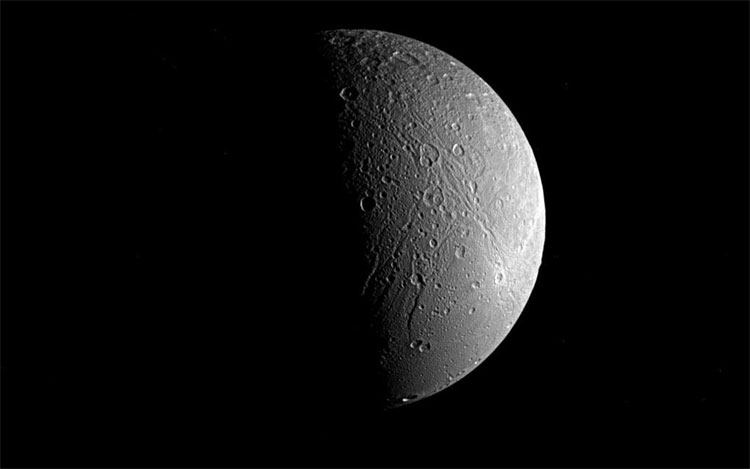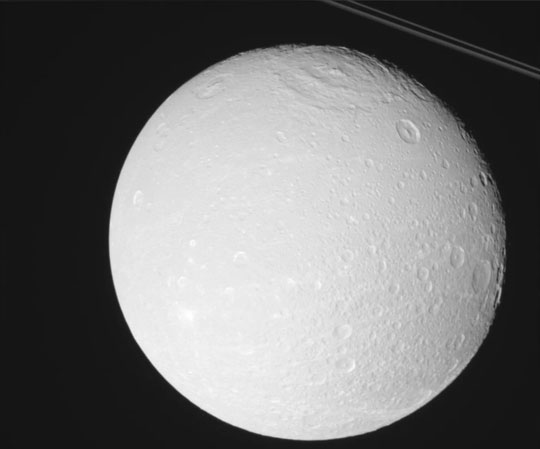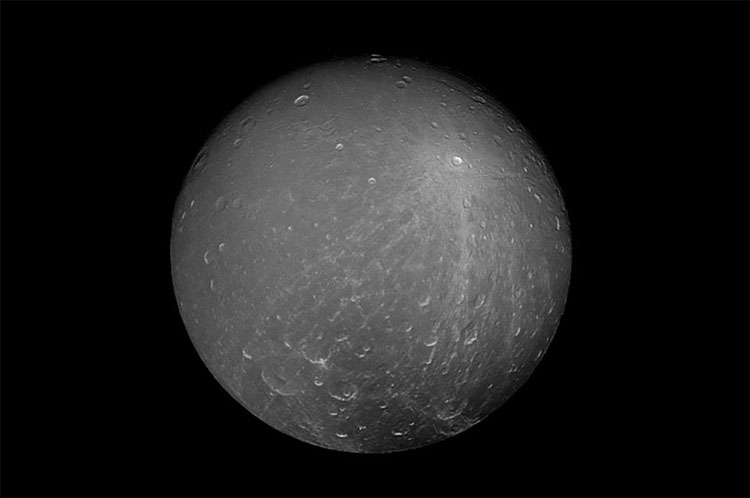Add a Saturn moon that owns the ocean and ... oxygen
Saturn's Dione moon is one of the targets of NASA's Cassini probe "to take special care" for possessing essential elements for life.
The final images were sent to Earth by the Cassini spacecraft and were announced by NASA recently showing close-up views of Dione - a little moon seen in images of Saturn.

Moon Dione - (photo: NASA).
The reason is that it seems to be quite overshadowed by the two brothers - Titan moon and moon Enceladus, the two "promised lands" of alien life because of the possession of the ocean below the icy surface. Recently, organic molecules on the moon Enceladus were discovered, leading to the hope of having a life form - at least evidence of ancient life on this celestial body.
However, according to Space, many scientists believe that Dione is a fatter version of Enceladus. The preliminary data Cassini brought about, including a close-up image of the surface and a small ray of particles captured by the spacecraft, showed that Dione also had signs of an ocean beneath the permafrost .
According to a study conducted by the Royal Astronomical Society of Belgium, the gravity data collected by Cassini shows that there is an ocean 100 km deep below the moon's ice surface! This ocean surrounds a large, solid rock core. The core is the reason why this moon is very heavy in weight compared to its relatively small size.

This moon is full of craters.(Photo - NASA).

Dione in other angles, also taken by Cassini - (photo: NASA).
According to scientist Attilio Rivoldini, one of the authors of the study, the interaction between water and ice, ie between the ocean and the moon's core, provides nutrients and energy resources, which are essential components of support. support life under water.
The Cassini spacecraft also found that the moon possesses oxygen in the atmosphere. However, the density of oxygen is very low compared to the earth, only one oxygen ion in every 11 centimeters of air.
Dione is similar to the strange Earth's moon, with its distance from Saturn at 377,400km, roughly the distance between the moon and the Earth. This moon, like our moon, is "locked" by the host planet, always facing Saturn with a single surface.
This icy moon reflects the white color in the real image taken by Cassini, exactly as it is, because its surface temperature is extremely low: minus 186 degrees Celsius. This is the fourth largest moon of 53. Saturn's satellites and the 15th solar system, with an average radius of 349 miles.
However, it is one of the moons . the most miserable in the solar system, because of Saturn's famous "ring" , the perimeter of the planet around it, constantly infested with countless large meteors. small. That's why this moon is full of craters, there are holes 100km wide, some others are 35km deep.
- There may be an ocean hidden deep beneath the crust of the moon Enceladus
- The giant ocean on Saturn's moon may contain life
- Cassini flies close to the moon of Saturn
- Saturn has a newborn moon
- 50 images of Saturn's Enceladus moon - where life can exist (Part 1)
- 50 images of Saturn's Enceladus moon - where life may exist (Part 2)
- NASA has revealed evidence that extraterrestrial life exists in the Solar System
- Little known facts about the Rhea Moon, Saturn
- How does Saturn's moon stripe form?
- People can fly like birds on Saturn moon
- The new discovery shook the hypothesis of life on Titan
- Add convincing evidence of life on Saturn moon
 Van Allen's belt and evidence that the Apollo 11 mission to the Moon was myth
Van Allen's belt and evidence that the Apollo 11 mission to the Moon was myth The levels of civilization in the universe (Kardashev scale)
The levels of civilization in the universe (Kardashev scale) Today Mars, the sun and the Earth are aligned
Today Mars, the sun and the Earth are aligned The Amazon owner announced a secret plan to build a space base for thousands of people
The Amazon owner announced a secret plan to build a space base for thousands of people